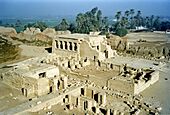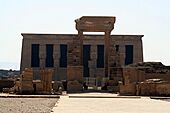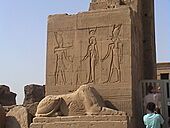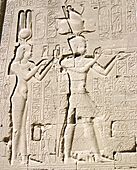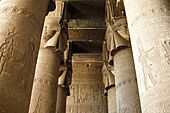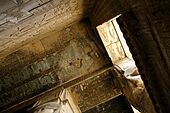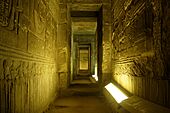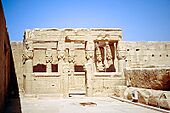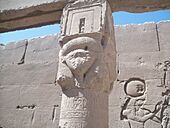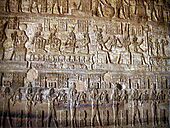Dendera Temple complex facts for kids
The Dendera Temple complex (Ancient Egyptian: Iunet or Tantere; the 19th-century English spelling in most sources, including Belzoni, was Tentyra; also spelled Denderah) is located about 2.5 kilometres (1.6 mi) south-east of Dendera, Egypt. It is one of the best-preserved temple complexes of ancient Egypt. The area was used as the sixth nome of Upper Egypt, south of Abydos.
Contents
Description
The entirety of the complex is surrounded by a sizable mudbrick wall. Dendera, an oasis on the banks of the Nile, was inhabited by thousands at its peak. Due to its massive size, the structures throughout the complex were constructed over many eras, such as the Middle Kingdom, the Ptolemaic Era, and the period characterized by Roman provincial rule. There is evidence that there was an even earlier building on this site, circa 2250 B.C.E., which could have begun during the reign of Pepi I and completed during the reign of his son, Merenre Nemtyemsaf I. Evidence also exists of a temple in the Eighteenth Dynasty (ca. 1500 BC). The earliest extant (surviving) building in the compound today is the mammisi raised by Nectanebo II – last of the native pharaohs (360–343 BC).
The features in the complex include:
- Hathor temple (the main temple)
- Temple of the birth of Isis
- Sacred Lake (source of water for sacred rituals and for everyday use)
- Sanatorium
- This would have functioned similarly to a Roman bathhouse, but strictly for bathing and an overnight stay to manifest healing dreams. The waters at Dendera were sacred and were often used to bless the inscriptions on statues so that they could cure diseases.
- Mammisi of Nectanebo II
- Basilica
- Roman Mammisi
- a Barque shrine
- (Def.: Boat; French, “barque”/ Late Latin “barca”)
- Used as a resting place for the statues of the gods when outside of the temple during festivals
- Gateways of Domitian and Trajan
- the Roman Kiosk
The Dendera Temple is not to be confused with the Dendera Necropolis, which consists of a series of tombs. The Dendera Necropolis dates back to the Early Dynastic Period and up to the First Intermediate Period, which pre-dates the Middle Kingdom construction of the Temple of Hathor. The necropolis runs across the eastern edge of the western hill and over the northern plain.
Hathor temple
The temple that dominates this complex, the structure that commands the attention of those who visit, is the Temple of Hathor. The original temple structure underwent continuous modifications throughout the Middle Kingdom and up until the beginning of the reign of the Roman emperor Trajan. The existing temple's structure began construction in 54 B.C.E, the late Ptolemaic period, under the reign of Ptolemy Auletes. The hypostyle hall was built in the Roman period under Tiberius.
In Egypt, Trajan was quite active in constructing buildings and decorating them. He appears, together with Domitian, in offering scenes on the propylaeum of the Temple of Hathor. His cartouche also appears in the column shafts of the Temple of Khnum at Esna.
Layout elements of the temple are:
- Large Hypostyle Hall
- Small Hypostyle Hall
- Laboratory
- Storage magazine
- Offering entry
- Treasury
- Exit to well
- Access to stairwell
- Offering hall
- Hall of the Ennead
- Great Seat and main sanctuary
- Shrine of the Nome of Dendera
- Shrine of Isis
- Shrine of Sokar
- Shrine of Harsomtus
- Shrine of Hathor's Sistrum
- Shrine of gods of Lower Egypt
- Shrine of Hathor
- Shrine of the throne of Rê
- Shrine of Rê
- Shrine of Menat collar
- Shrine of Ihy
- The Pure Place
- Court of the First Feast
- Passage
- Staircase to roof
Depictions of Cleopatra VI, which appear on temple walls, are good examples of Ptolemaic Egyptian art. On the rear of the temple exterior is a carving of Cleopatra VII Philopator (the popular, well-known Cleopatra) and her son, Ptolemy XV Philopator Philometor Caesar (Caesarion), who was fathered by Julius Caesar.
There are ten dead deities represented at Dendera, specifically on/in Hathor's temple, that can be connected to the nine dead deities at Horus's temple in Edfu. This would be due to the either parental or marital relationship between Hathor and Horus.
Dendera zodiac
The sculptured Dendera zodiac (or Denderah zodiac) is a widely known relief found in a late Greco-Roman temple, containing images of the zodiac system still recognized today (i.e. Taurus [bull] and Libra [scales]). A sketch was made during the Napoleonic campaign in Egypt. In 1820 it was removed from the temple ceiling by French colonizers and later replaced with a copy. There is controversy as to whether they were granted permission by Egypt's ruler, Muhammad Ali Pasha, to do so, or whether they stole it. (It is also said that in 1822, an antiquities thief using the name "Claude Le Lorraine" [not to be confused with the French Baroque painter] removed the zodiac from Dendera, brought it back to France, and sold it to the King.) The real one is now in the Louvre. Jean-François Champollion, the man who deciphered the Rosetta Stone, dated it back to the Ptolemaic period, and it has been proved that he was correct, as Egyptologists now date it back to the first century BC.
Crypts
The Hathor temple's subterranean tombs contain twelve chambers. Some reliefs seen in the tombs are dated to as late as the reign of Ptolemy XII Auletes. The crypts reportedly were used for storing vessels and divine iconography. An opening in the Flame Room floor leads to a narrow chamber with representations on the walls of the objects which were kept in them. In the second chamber, a relief depicts Pepi I offering a statuette of the God Ihy to four images of Hathor. (Hathor is understood to be Ihy's mother.) In the crypt accessible from the Throne Room, Ptolemy XII has jewelry and offerings for the gods.
The Dendera light
The Hathor Temple has stone reliefs that depict Harsomtus, in the form of a snake, emerging from a lotus flower. Harsomtus, also known as Horus, is depicted as one of the ancient gods, a "primeval creator." Harsomtus is likely depicted at the Dendera Temple Complex due the main temple being dedicated to Hathor. In Egyptian mythology, Harsomtus is referenced as either Hathor's son or lover. In six reliefs he is positioned within an oval container called a hn, which might represent the womb of Nut. These resemble a lamp or light.
Restoration work
The Supreme Council of Antiquities began the project of restoration and maintenance of the temple in 2005. Efforts stopped in 2011 and then resumed in 2017, after the completion of necessary scientific and archaeological studies, along with careful experimental studies using modern techniques. As of March 2021, the second phase of the restoration has been completed, which includes cleaning the Great Pillars Hall and restoring the original colors and clarity of painted scenes on walls and ceilings. More activity continues at the temple, including a cooperative effort started in 2019 with the French Archaeological delegation to turn the temple courtyard into an open museum.
Roman mammisi
The Roman mammisi is a subsidiary building dating to the reigns of Trajan and Marcus Aurelius. Numerous reliefs of Trajan making offerings to Egyptian deities can be seen. The presence of the Roman mammisi at the Dendera Temple Complex is indicative of the long and complicated history of the Romans in Egypt. As seen in the images below, Roman Emperor Trajan is depicted in the reliefs as an Egyptian Pharaoh and he is making offerings to the Egyptian gods.
-
Roman Emperor Trajan at Dendera, Egypt
-
Roman Emperor Trajan brings offerings to Hathor and Ra-Harakhte, Dendera.
Recent discoveries
In March 2023, during the recent excavations at the site archaeologists uncovered a limestone sphinx. This sphinx is depicted with a slight grin and dimples and is thought to have been created in the image of the Roman emperor Claudius. On the sphinx's head sits a nemes that has a cobra-shaped tip called a uraeus.
Tourism
The Dendera complex has long been one of the most tourist-accessible ancient Egyptian places of worship. It used to be possible to visit virtually every part of the complex, from the crypts to the roof. However, the highest part of the roof of Hathor temple has been closed since 2003.citation needed] The second stage of the roof was closed in November 2004. [citation needed]
Gallery
-
Entrance gate to the temple, with bas-relief and sphinx
-
Reliefs of Cleopatra VII and her son by Julius Caesar, Caesarion at the Dendera Temple
See also
- Esna temple (in Esna)
- List of Ancient Egyptian sites
- Tomb of Meni
- Tomb of Nyibunesu


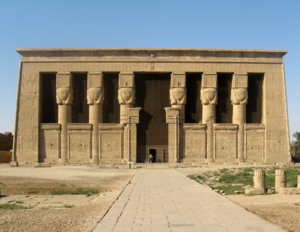
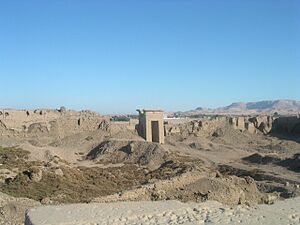
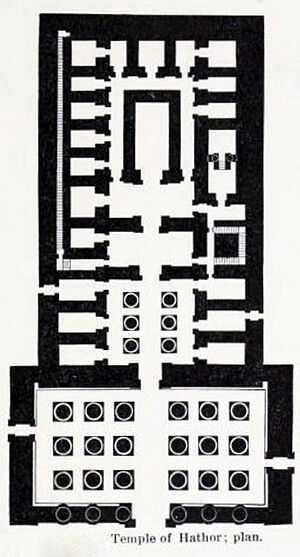
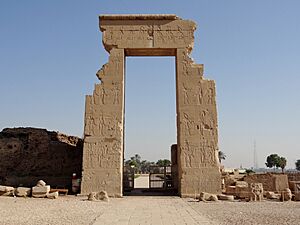
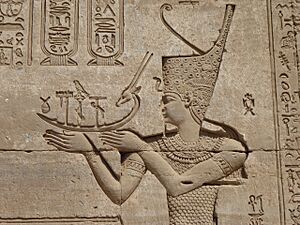

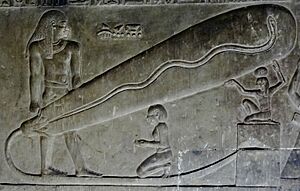



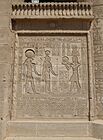
![Emperor Trajan as a Pharaoh making an offering to the Gods, in Dendera.[20]](/images/thumb/6/69/Emperor_Trajan%2C_Dendera.jpg/120px-Emperor_Trajan%2C_Dendera.jpg)
